December 9, 2016
Air Date: December 9, 2016
FULL SHOW
SEGMENTS

Dakota Access Blocked
View the page for this story
On December 4th, the Army Corps of Engineers announced that it would not grant the Dakota Access Pipeline an easement to drill under Lake Oahe without further review, and some are celebrating the decision as a victory for the Standing Rock Sioux tribe. Yet while the Corps has decided to do additional environmental review and look into alternative routes, the waters that the Standing Rock Sioux and their allies aim to protect might still be at risk. Host Steve Curwood spoke with Vermont Law School professor Pat Parenteau about how the Trump Administration might influence the pipeline’s progress. (12:50)

Freshening China’s Fish Farms
/ Jocelyn FordView the page for this story
Consumer demand in both the U.S. and China for safe and healthy farmed fish is shaping aquaculture practices in the world’s most populous country. And fish farmers are using traditional Chinese medicine as well as high-tech monitoring systems as they strive to keep their fish healthy and their farming practices transparent. Jocelyn Ford reports from the Hainan Province. (18:00)

Beyond the Headlines
/ Peter DykstraView the page for this story
Peter Dykstra and host Steve Curwood discuss the fossil fuel industry ties of Oklahoma AG Scott Pruitt, President-elect Donald Trump’s pick for EPA Administrator, and new evidence that polluted rivers date back to the Stone Age. (04:20)

Tom Friedman on the Age of Acceleration
View the page for this story
New York Times columnist Tom Friedman’s latest book, Thank You For Being Late: An Optimist’s Guide to Thriving In The Age Of Accelerations, is a manifesto for how to cope with our changing planet. Host Steve Curwood spoke with Mr. Friedman about how to make sense of technology, globalization and climate change as these three forces simultaneously accelerate at unprecedented rates. (12:00)
Show Credits and Funders
Show Transcript
HOST: Steve Curwood
GUESTS: Pat Parenteau, Peter Dykstra, Thomas Friedman
REPORTERS: Jocelyn Ford
[THEME]
CURWOOD: From Public Radio International, this is Living on Earth.
[THEME]
CURWOOD: I'm Steve Curwood. A win for the moment for the ‘water protectors’ opposing the Dakota Access Pipeline…
PARENTEAU: The Corps is telling the pipeline company you do not have all the necessary approvals to complete the project. We are going to engage in a longer review process and we’re going to look harder at alternative routes for this that avoid the Lake Oahe crossing.
CURWOOD: But the incoming Trump administration may have other ideas. Also, fish farms in China aim to clean up their operations and reassure consumers in both the US and at home.
KUMAR: A customer buys a bag of fish. You have a QR code on the bag. Run your smartphone through our QR code on the bag. And you will have a chance to see the actual farm that raised this fish in your bag.
CURWOOD: How both high-tech and traditional practices could make farmed fish safer. Those stories and more this week, on Living on Earth. Stick around.
[NEWSBREAK MUSIC: Boards Of Canada “Zoetrope” from “In A Beautiful Place Out In The Country” (Warp Records 2000)]
[THEME]
Dakota Access Blocked

Celebratory fireworks light up the sky at the Sacred Stone camp on December 4th, following the Army Corps of Engineers’ announcement that it would not grant the Dakota Access pipeline an easement to drill under Lake Oahe. (Photo: Joe Brusky, Flickr CC BY-NC 2.0)
CURWOOD: From the Jennifer and Ted Stanley studios at the University of Massachusetts Boston and PRI, this is Living on Earth. I’m Steve Curwood. On December 4, opponents of the Dakota Access Pipeline in North Dakota won a significant battle, but it’s unclear if they have won their campaign to protect the waters and sacred grounds of the Standing Rock Sioux. The Obama Administration said it is not ready to grant an easement that the pipeline needs to pass under the Missouri River close by the reservation. And to underscore the concerns of the protestors who call themselves “water protectors,” on December 6, a state health official said a “significant” crude oil pipeline leak was found to have polluted a creek just 200 miles from where Standing Rock demonstrators have been camped. The incoming Trump administration has expressed support for Dakota Access, and to explain the legal options for both sides of the dispute we turn now to Vermont Law School professor Pat Parenteau. Pat, welcome back to Living on Earth.
PARENTEAU: Thank you, Steve.
CURWOOD: Pat, about this easement. It wasn't granted, and so people are celebrating. Well, they're celebrating cautiously. What does that mean from a legal perspective?
PARENTEAU: Well, what it means is, the corps is telling the pipeline company you do not have all the necessary approvals to complete the project and put the pipe under the Lake Oahe. We are going to engage in a longer review process, we're going to produce an environmental impact statement, we're going to consult further with the tribe, and we're going to look a lot harder at alternative routes for this that avoid the Lake Oahe crossing, and that's going to take a long time, many months, and the company of course is not very happy about that.
CURWOOD: So, to be clear here, the government hasn't really revoked anything here, it just hasn't issued the final order and says that there are other conditions that are necessary for the final order?
PARENTEAU: That's correct. The government takes the position that three approvals are needed. One of them is under the Clean Water Act and that's where the pipeline crosses a number of streams and wetlands. The second one is under the Rivers and Harbors Act. This is a very old 1899 statute that requires permission from the Corps of Engineers for use of federal property, and of course Lake Oahe is a federal reservoir. It was created by the Garrison dam authorized by Congress many years ago, so that's a separate authorization under the Rivers and Harbors Act, and then the third one which is the one that's now the focal point is under the Mineral Leasing Act, and this is a specific right-of-way for pipelines that cross federal land such as Lake Oahe.
CURWOOD: Pat, I understand on the heels of the administration saying, Nope, we're not cannot permit this thing at least at this time,” that the pipeline company went back in to court to push back. What did they do?
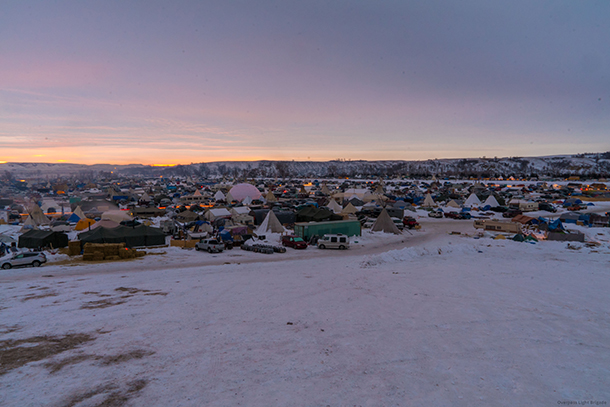
Snow now blankets the Sacred Stone camp where the Standing Rock Sioux and their allies have been camped since August, as the bleak North Dakota winter approaches. (Photo: Joe Brusky, Flickr CC BY-NC 2.0)
PARENTEAU: Yeah, the pipeline company is basically saying that the earlier approvals that the Corps of Engineers has given to the project and specifically to the crossing under Lake Oahe should be the final word on the right-of-way that they need and that the Corps has unlawfully changed its mind and now wants to revisit those earlier approvals under the guise of needing yet further approval under this Mineral Leasing Act requirement. And so the company is basically saying, “You gave us the green light before. Now under a lot of political pressure you want to backtrack on that, and that we don't think the court should allow you to do that. We want the court to order you to give us whatever final approval we need to complete this project. We've waited long enough.” So, that'll be an issue that the D.C. court is going to have to consider very quickly, probably within the next few weeks, and determine whether or not the company has a legitimate argument that the corps really shouldn't be able to reconsider decisions it's made before.
CURWOOD: And how can the Standing Rock Sioux folks push back on that demand?
PARENTEAU: The Standing Rock folks can also go to court and argue that the Corps of Engineers has made the correct decision, that it should engage in this full environmental review, and that, in the end, that review will show that this pipeline should not be placed under Lake Oahe but should be rerouted to avoid their water supply.
CURWOOD: What are the options, then, of the incoming Trump administration to speed up this process?
PARENTEAU: One thing the Trump administration could do would be to simply terminate the environmental review process and have the Corps of Engineers issue this final right-of-way and allow the project to be finished. Of course, that decision will be challenged by the tribe. There's a pending lawsuit in the United States District Court for the District of Columbia, and that case would be the forum for the tribes to challenge a Trump administration's order to simply issue the right-of-way and terminate the review process. The argument would be that's a purely arbitrary decision motivated by political motives -- a new administration, no new information, no changed circumstance, just simply a political decision to stop the process. And I believe the courts will look skeptically on a decision to simply terminate the environmental review process as opposed to let it run its course.
CURWOOD: So, one step at a time here then. How long would it take for this environmental review to take place? In other words, how soon might the Dakota Access pipeline people be able to continue this even with a favorable Trump agency behind this process for them?
PARENTEAU: My estimation is it would take 6 months to a year to do a full environmental impact statement, which requires, among other things, opportunity for public comment, opportunity for public meetings. Of course ever already been a number of these meetings and consultations, but this one is going to be much more focused on, for example, the original route for this pipeline was 10 miles north of Bismarck, and the corps has signaled it wants to take another look at that route and why that route was not selected by the company. And there are many other questions about pipeline safety and security. There's these questions about whether the tribe actually has some special treaty rights that were recognized in this old 1851 Treaty of Fort Laramie that deals with Lake Oahe. So that kind of a process is going to take months, and of course that would be litigation after all that is done as well. So, we're quite a long ways from a final decision, if the process is allowed to play out.
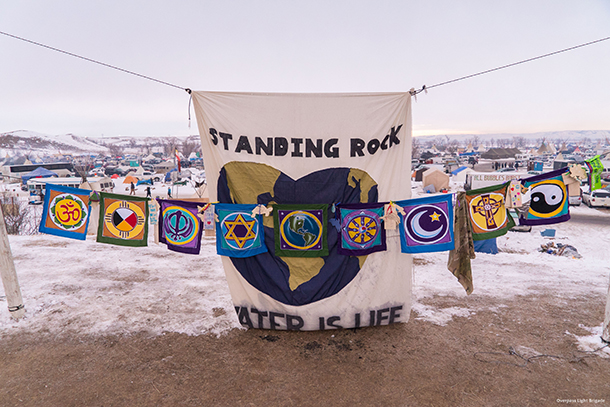
Flags hang in the style of Tibetan prayer flags at the Sacred Stone camp (Photo: Joe Brusky, Flickr CC BY-NC 2.0)
CURWOOD: Sounds like in any event that the folks who been out there demonstrating and protesting this won't have to sit out there through this winter, that the earliest that any movement might come on this would be when the weather perhaps is a bit warmer.
PARENTEAU: Oh, I think that's true and, in fact, the tribal chairman David Archambault II has encouraged people to leave the sort of frozen grounds of the camp that they've established, that it’s really not very safe. This is pretty harsh conditions up there, and he's telling people go home and get warm, and wait and see what happens, but I've also heard from protesters on site that they're not leaving, that they don't trust the government probably for good reason, given the history of the government's treatment of these native peoples up there. So I don't know whether they're going to stick it out through the winter or not. Sounds like at least a good portion of them will stay.
CURWOOD: So, if this decision stands that there’ll be this environmental impact review, and the route has to be moved, who pays?
PARENTEAU: Well, the promoters of the pipeline, I think it's called Energy Transfer Partners based in Dallas Texas, as I understand it. This is a private company and a privately funded project. I think there are 17 banks at least -- Citibank is a big one -- are the financing the project. This is a debt finance project because it's several billion dollars, almost $four billion as I understand it, but if it has to be rerouted at no doubt considerable cost, it would fall on the pipeline owners and the banks that they are relying on for financing to get it done.
CURWOOD: What recourse could they have against the government saying, “Hey, look, you guys said we could do this and now you can't. It's going to cost us a bundle of cash.”
PARENTEAU: If they are able to convince the court that this latest decision by the Corps of Engineers is actually illegal and that they're entitled to the right-of-way, that's probably the company's best bet for avoiding having to reroute the project. If the court upholds what the Corps of Engineers is doing and ultimately upholds a decision to require a rerouting, the company wouldn't have a leg to stand on to claim compensation for that. That would just be the consequence of the exercise of regulatory authority, but I also have to say it's hard to imagine, with the Trump administration in office, it's hard to imagine that the Corps of Engineers is in fact going to mandate that they change the route of this pipeline. We’ll have to wait and see, and I know the tribe is counting on maybe that being the outcome, but I think that's very much in doubt.
CURWOOD: By the way, what did you make of the veterans groups joining the demonstrations there at the very end?
PARENTEAU: I thought that was really a remarkable show of solidarity by people that you wouldn't normally think would be coming to the aid of protesters, but a really admirable, courageous thing to basically provide protection for the protesters and stand with them on...not necessarily maybe even agreeing with their position on the pipeline, but certainly saying, ‘We agree with your First Amendment right to do what you're doing, and we've sworn to defend the United States and the United States Constitution, and we're going to stand with you to make sure that your civil rights are protected in this process.’ Pretty admirable thing to see.
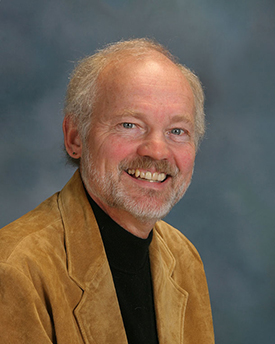
Pat Parenteau is an environmental law expert and a professor at the Vermont Law School. (Photo: Vermont Law School)
CURWOOD: When the authorities used a water cannon that freezing night, I was reminded of Bull Connor at the bridge in Selma using firehoses in the civil rights movement and that when the nation saw that it was a turning point in the Civil Rights movement. To what extent might this be a turning point in the rights of Native Americans?
PARENTEAU: Right, I had the same reaction watching the militarized force being brought to bear on these protesters and frankly the incredible contrast with what happened with the Bundy group that took over the Malheur your national wildlife refuge for 40 days and were acquitted of any charges whatsoever for those actions. So, on the one hand you have protesters actually taking over possession of a Federal refuge and doing damage, serious physical damage to the refuge, and on the other hand you have a group of mostly peaceful -- You can't say that it was 100 percent there are always some people in any crowd that are going to cause trouble perhaps -- but mostly peaceful protesters having dogs sicced on them, water cannons sicced on them, rubber bullets fired at them. Very, very severe police reaction to their protest, and I hope that people watching this would be concerned. Yes, you need to reestablish law and order, but on the other hand, if you can't create a safe space for people that are legitimately concerned about a project that poses at least risk to their water supply even if you can't prove beyond a doubt that it will damage the water supply -- We do that pipelines leak after all -- If people can't protest projects like that without being subjected to these extreme crowd control measures, that says something about the state of our democracy, I think, in the United States, and their at least should be serious consideration for how these kinds of protests are going to be handled because this isn't the end. Whether it's climate or whether it's Native American communities threatened by projects or whether it's Black Lives Matter threatened by extreme police force, we know that across the length and breadth of America, the tensions that are arising or not being handled I think in the way that we would like to see them handled, and so that's a much broader discussion to be having. But Standing Rock is a symptom, I think, of a deeper problem with the way democracy is working in the United States right now.
CURWOOD: Pat Parenteau is a law professor at Vermont Law School. Thanks so much for taking time today, Pat.
PARENTEAU: My pleasure, Steve.
Related links:
- New York Times map of the Dakota Access Pipeline controversy
- EarthJustice filed a lawsuit on behalf of the Standing Rock Sioux tribe
- Belle Fourche Pipeline spill in western North Dakota on December 5, 2016
- Living on Earth’s previous interview with Pat Parenteau on the Dakota Access Pipeline
[MUSIC: Vince Guaraldi Trio, “Christmas Time Is Here” on A Charlie Brown Christmas, Vince Guaraldi, Charlie Brown Records]
CURWOOD: Coming up, using traditional Chinese medicine to make farmed fish healthier. Stay tuned to Living on Earth.
ANNOUNCER: Support for Living on Earth comes from the Gordon and Betty Moore Foundation, and from a friend of Sailors for the Sea, working with boaters to restore ocean health.
[CUTAWAY MUSIC: Vince Guaraldi Trio, “Christmas Time Is Here” on A Charlie Brown Christmas, Vince Guaraldi, Charlie Brown Records]
Freshening China’s Fish Farms
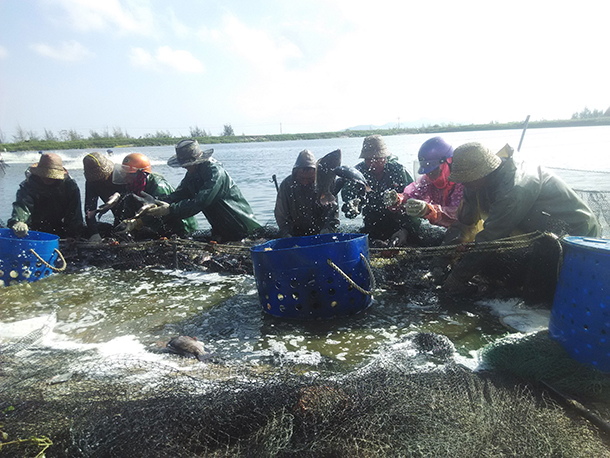
Harvesting tilapia for export on an internationally certified farm (Photo: Jocelyn Ford)
CURWOOD: It’s Living on Earth. I’m Steve Curwood. If you buy fish sticks or tilapia filets, chances are they came from fish grown on a farm in China. But the rising middle class in China and the hunger in America for quick and convenient fish products have led to practices that can be unhealthy for both humans and the natural environment. Aquaculture dates back thousands of years in China, but surging demand has led in some cases to pollution and the overuse of antibiotics. We sent Beijing-based reporter Jocelyn Ford to the island of Hainan, a major base of aquaculture in South China, where fish farmers are using everything from high tech to traditional medicine to clean up their industry.
But first she took a detour to Hollywood –
[DORY? DORY!]
CURWOOD: which recently has been enjoying a boom in animated fish.
[MUX from soundtrack “FINDING DORY”]
DORY: Wait, wait, no, I know where my parents are, they’re in...um, uh, what's it called? The place... Soap ’n Lotion?
OTHERS: Open ocean.
DORY: Open ocean.
OTHER: Open ocean! I know where that is!
FORD: Ah, the romance of colorful fish swimming freely in the wide open ocean! In the Disney version, the heroine is Dory. She triumphs when she escapes from human captivity, and swims back to her parents. But in the real world, it is the captive fish that are heroes, the fish on fish farms. They're saving the wild fish.
HAN HAN: With such a huge population in China, if we didn't have aquaculture, if we totally relied on the wild fishery. I guess we would already running out of all these wild fish, maybe 10 or 20 years ago.
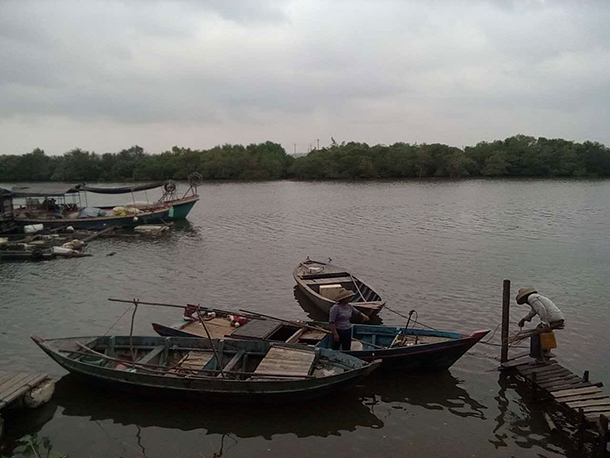
Fishing boats on Hainan. China relies on aquaculture for most of its seafood (Photo: Jocelyn Ford)
FORD: That's Han Han, the founder of the China Blue Sustainability Institute, China's first non-governmental, environmental organization focused on sustainable fishing and aquaculture. Today, aquaculture accounts for one of every two fish that land on the dinner table worldwide, and it's growing faster than other sources of animal protein. China is the global aquaculture leader, and because of its expertise here, it wants to help other countries. Fisheries Bureau Deputy Director General, Li Shumin says...
LI SHUMIN [translated with voiceover]: We have many good aquaculture technologies that we would like to share with other developing countries because we know that fishing is not going to be sustainable.
FORD: Aquaculture is expanding globally at about five percent a year, and that’s a plus for some of the Earth's most pressing environmental issues. For example, compared to a pound of beef, a pound of fish has only about one-seventh of the carbon footprint. But large-scale aquaculture has created new problems. Naturally, farmed fish need to eat. And gone are the days when Chinese fish farms were all organic. Qi Genliu is a professor at Shanghai Ocean University.
QI: Traditionally we used grass to culture grass carp.
FORD: That changed with the growth of the fish feed industry and the need to feed carnivorous marine fish.
QI: Now we use feeds. It will not only more efficient, but it will also save labor.
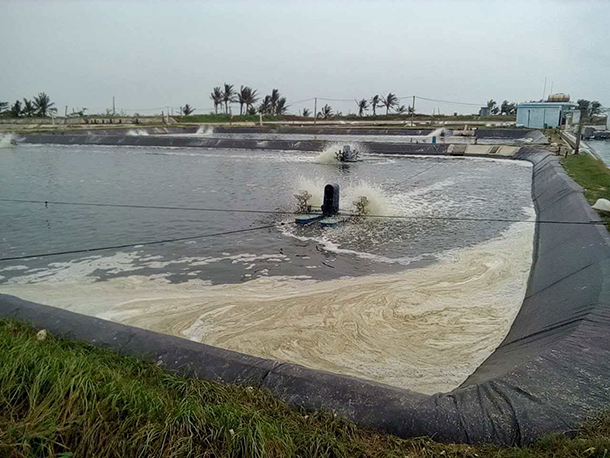
Waste water is released untreated into the ocean at this hatchery in Hainan (Photo: Jocelyn Ford)
FORD: About a quarter of global wild fish catch is used for fishmeal or fish oil. So now many of the so-called “trash fish,” which include anchovies and the young of other species, are being overfished. Then, there’s the problem of water quality. In China, many farmers overstock their ponds, and don’t properly clean the water. Fish get sick. The farmers dump in antibiotics. Again, Han Han, of the China Blue Sustainability Institute.
HAN HAN: We can produce all this seafood in such a low cost. It is because we have been industrialized to produce them in a massive scale. That can lower your new unit cost, but you didn't take into account the massive pollution.
[CAR DOOR, TAXI DISCO MUSIC]
FORD: Hop into a taxi, drive around 90 minutes from Han Han's office, and you reach Wenchang. This is the capital of fish farming on China's tropical southern island of Hainan. The roads are lined with coconut palms and artificial ponds. There are square ponds the size of several volleyball courts, and oblong ones as big as soccer fields. Fan Qingwei is a sea cucumber production manager. He agreed to give me an unauthorized tour of his former hatchery.
[FOOTSTEPS AND WATER TANK]
FORD: What’s this?
FAN: Sea cucumber.
FORD: Is that one of your babies?
FAN: Yeah.
FORD: It’s cute, it’s slimy.
FORD: Fan Qingwei’s claim to fame. Last year he bred one-and-a-half million baby sea cucumbers, a Chinese delicacy that is said to have health benefits. He takes me to the beach, a stone’s throw beyond the hatchery’s ponds.
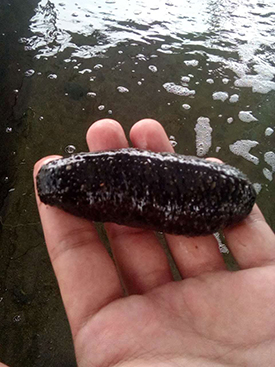
The sea cucumber is a Chinese delicacy (Photo: Jocelyn Ford)
[WAVES, WALKING ON BEACH]
FAN: The water pour out the pipe, here.
FORD: Let me go take a look. Oh, there's a crab!
FORD: The hatchery is a few hundred feet from the ocean. Technically that's a violation of recent regulations. The water is discharged without treatment.
FORD: So the water's really sort of murky and brown and foamy. Not great quality, huh?
FAN: Yeah, not great quality.
FORD: Depending on who you talk to, there are hundreds or thousands of such farms. Many are small, family-owned factories that operate under the radar screen. They release water back into the sea that is contaminated with fish waste, as well as left over fish feed and medicines such as antibiotics. The concoction is like a witches brew. It worries some experts such as Cai Yan.
CAI YAN: Antibiotics kill a lot of bacteria. So they reduce the diversity of microbes in the environment.
FORD: Professor Cai Yan is an aquaculture researcher at Hainan University.
CAI YAN: You actually resulted in more super bacteria that you can't do anything with them. You know, you can't kill them. So if these bacteria, these super bacterias, go into the human system. OK, one day you get sick, you don't have any medicines to kill it. That is the big worry.
FORD: While Professor Cai Yan says there are no known cases in Hainan of humans getting sick from super bacteria, marine technician Fan Qingwei says, fish farmers are having problems. Medicines they once used when fish fell ill are no longer effective. Some farmers have seen big die-offs.
FAN [translated with voiceover]: The damaged environment has already hurt their profits.
FORD: The government has taken action. It's banned the carcinogenic antibiotics, and in Wenchang created a fund for a water treatment plant. The idea is that all the farmers could send their dirty water through the plant before it returns to the ocean. But with so many small operations, the project would be both costly and complicated. And it’s unclear if it’ll get off the ground.
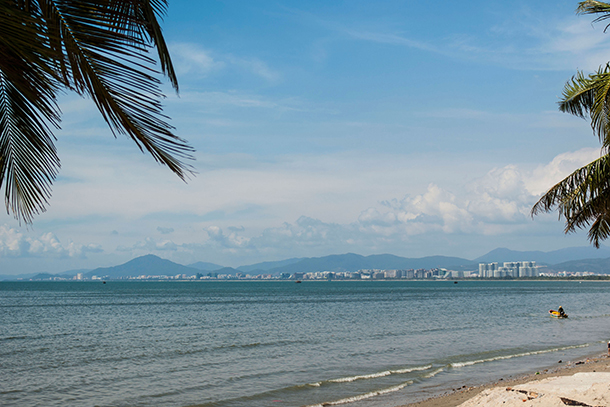
The beaches and mild climate of the island of Hainan make it a popular destination for vacationers from China and abroad as well providing favorable conditions for fish farmers. (Photo: Thomas Fischler, Flickr CC BY 2.0)
There also aren't enough inspectors to police every farm. But my visit to Fan Qingwei's hatchery suggests some government scare tactics are having an impact on reducing the use of antibiotics.
[SOUNDS VIDEO GAME]
It's lunch break. 30-year-old worker Huang Defu, in charge of shellfish at the hatchery, is busy with his cell phone.
FAN: He's playing the game in the cell phone.
FORD: Wait for him to finish his game.
[SOUNDS OF VIDEO GAME]
FORD: The conversation turns to recent, high-profile arrests of fish farmers.
FAN [translated with voiceover]: The government tests the fish. If they find you using illegal antibiotics, they might put you in jail.
FORD: So, the boss has ordered Huang Defu to use, instead, probiotics, the kind of good bacteria that's found, for example, in yogurt. Across the ocean, health-conscious consumers in America are also helping make farming practices here in China safer and more environmentally friendly.
[COMMERCIAL JINGLE "Gorton's crunchy fishsticks and filets. Absolutely no preservatives."]
FORD: China is the largest single exporter of tilapia to the U.S. 95 percent of tilapia farmed on Hainan ends up on U.S. store shelves, much of it as filets or fishsticks.
So when a couple of years ago some of China's fish shipments to the U.S. were rejected due to unsafe antibiotics, exports took a hit. Companies like Gorton’s try to reassure consumers with generic pledges on their website. But regaining trust isn’t as simple as singing a jingle. Han Xuefeng heads the two-year-old Hainan Tilapia Sustainability Alliance. He says for the Tilapia industry, boosting quality is a matter of life or death.
HAN [translated with voiceover]: Since prices fell in 2014, we've felt we are on the brink of a crisis.
FORD: A number of small farmers and processing plants have gone out of business. Others are teetering. But the Chinese character for "crisis," weiji, also means “opportunity.”
HAN [translated with voiceover]: What we need to do now is to find out how to promote sustainable production in order to make use of the opportunity. We’ve already worked hard to make many people in the industry realize the importance of sustainability.
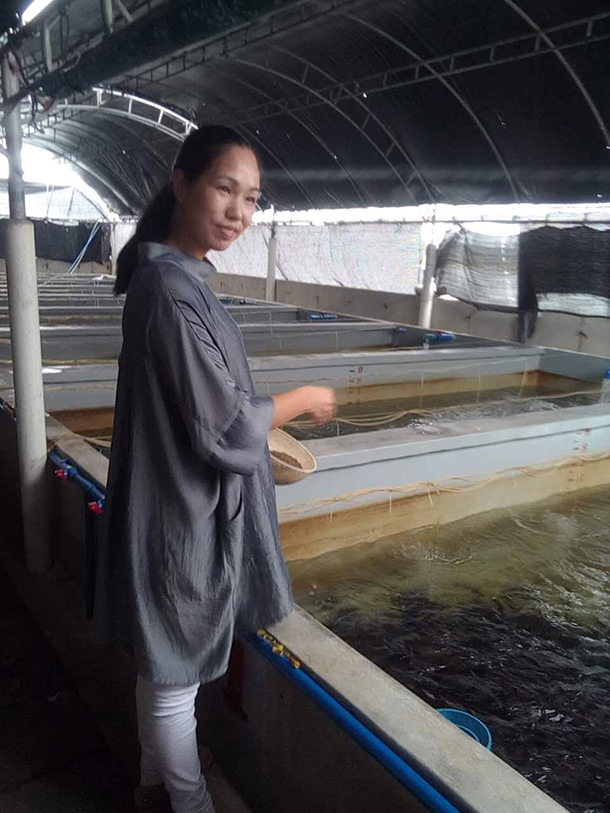
Zhang Meiyu feeds the fish she raises with Chinese herbal medicine techniques (Photo: Jocelyn Ford)
FORD: Han Xuefeng's association has found a partner in the island's most important export market. Two years ago, The Fishin’ Company, America's largest tilapia importer, stepped up to the plate.
[VIDEO SOUND TRACK with man's voice "I should not be here, actually, right? But the reason I'm here, is..."]
FORD: The founder and president of The Fishin’ Company, Manish Kumar, started coming to Hainan to build a coalition for a safer, more environmentally sound and sustainable tilapia industry. His company is sponsoring trainings, and offering financial incentives to a few model farms that invest in improvements. The idea is, others will follow suit if they see it makes financial sense. Many of the small fish farmers have no prior professional training. So the Fishin’ Company starts with simple things, like helping farmers keep records. They track weather conditions and water temperature, which affect fish health. And the farmers keep records of the feed and the medicine they use. The plan is to help more farmers get international certification by third parties. It's a brave, bold move for the industry leader and a contrast to Manish Kumar's diffident demeanor.
KUMAR: Hey Jocelyn, I haven't probably warned you, but I'm extremely nervous, uh...
FORD: Am I scary?
KUMAR: Not at all...
FORD: As America's largest tilapia importer and the supplier for Walmart, Manish Kumar has a lot at stake.
KUMAR: I'm gambling for the future prosperity, of this industry, which has given me so much, which is my career, and I'm gambling against losing my reputation. And I'm gambling very hard for positive change.
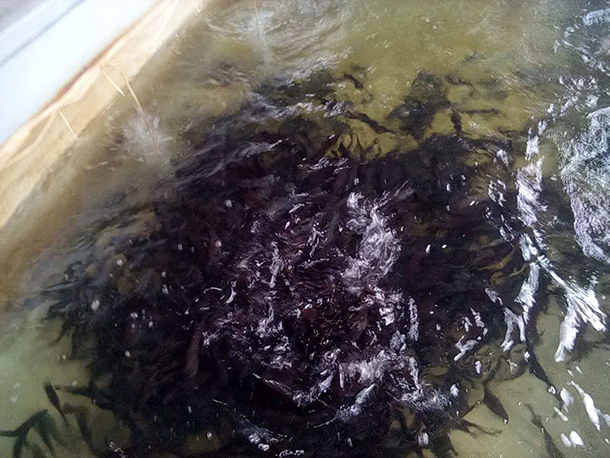
Fish in Zhang Meiyu’s aquaculture ponds (Photo: Jocelyn Ford)
FORD: His ideas include increasing omega-3 levels in the tilapia, the fish oil that may help lower risk of heart disease, cancer and arthritis. To help reassure customers who are nervous about what their fish are eating, next year he's planning a state of the art oversight system that involves cameras, QR codes, and consumer monitoring.
KUMAR: We will now proceed to do something no one in the industry has done before. Put a camera system into the farm area. A customer buys a bag of fish. You have a QR code on the bag. Run your smartphone through our QR code on the bag, and you will have a chance to see the actual farm that raised this fish in your bag. And how it's being raised.
FORD: Customers can see the type of feed, and the plant where the feed was made, and the insomniacs can watch the fish grow 24/7. Manish Kumar says the extra cost will be negligible. As the largest supplier of tilapia, he expects to be able to take advantage of economies of scale.
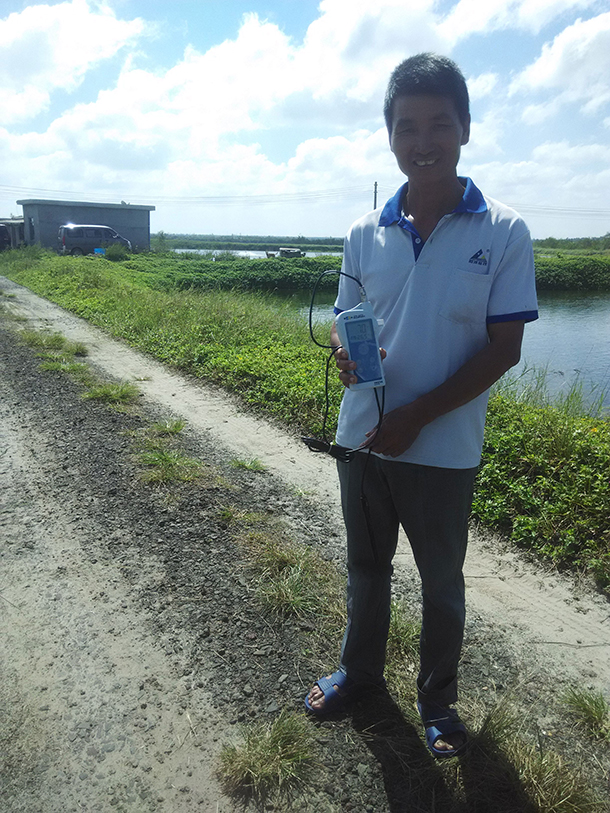
A fish farmer participating in the Fishin’ Company’s training program. (Photo: Jocelyn Ford)
KUMAR: I see, in the early part of next year, us having the ability to, through our packaging, give customers who have any, even a shred of doubt, feel better about what they are buying from us. And, I challenge the rest of the industry to do it. And then the people who don't do it will be the ones on the hot seat.
FORD: Meantime, the picture is different for Chinese consumers. They have more reason to be concerned about food safety than Americans. As of today, Chinese consumers don't have much of an appetite for frozen tilapia. Many prefer to purchase their fish live rather than frozen, but they are increasingly concerned about what goes into their food, and Han Xuefeng of the Hainan Sustainable Tilapia Alliance sees that as an opportunity.
[SPEECH BY MOTIVATIONAL SPEAKER FOLLOWED BY APPLAUSE]
FORD: On this day Han Xuefeng and his staff attended a lecture on how to build a brand. He thinks, as an island, Hainan can profit from the argument that it’s water is less polluted than water in other parts of China where Tilapia is farmed.
HAN [translated with voiceover]: We're at a turning point. Before Chinese were only concerned about how to get enough food to eat. Now they want it to taste good and be healthy and safe.
FORD: Meanwhile, some erstwhile consumers are taking matters into their own hands, by producing fish they can trust.
[SOUND OF BEATING THE SIDE OF A TANK]
Not far from the sea cucumber hatchery Zhang Meiyu is signaling to her fish that it’s feeding time.
[SOUND OF BEATING THE SIDE OF A TANK]
FORD: She is improbably dressed in high heels, tight white pants and a fashionable gray tunic, and she’s wearing blue eyeshadow. Zhang beats the side of the tank, and a large mob of fish swarm toward her.
FORD: What kind of fish?
ZHANG (in Chinese): Zhege shi longban.
FAN: Grouper.
FORD Just over a year ago, Zhang vacationed on Hainan, known as China's Hawaii. Then, on the spur of the moment, she decided to buy an abandoned fish hatchery. Within a month she’d relocated to the island.
ZHANG [translated with voiceover]: I had been in business. I didn't understand fish. I'd never touched one. But I discovered all the farmed fish back home was frightening. Even if you give it to me, I won’t eat it.
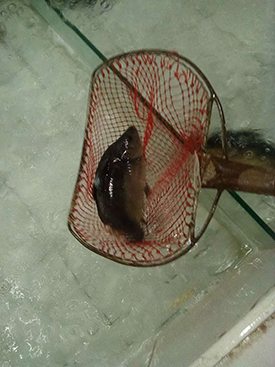
A fish from a Beijing restaurant (Photo: Jocelyn Ford)
FORD: Zhang had a dream. She wanted to have safe fish and create a brand that others could have confidence in. She believed she could do so by using a new version of an ancient practice: Chinese herbal medicine, but for fish.
ZHANG [translated with voiceover]: Everyone laughed at me and said I was crazy. They don’t trust Chinese herbal medicine.
FORD: Zhang Yumei is a pioneer in her neighborhood, but Chinese scientists have been researching how to farm fish using Chinese herbal medicine for many years. Dr. Guo Weiliang conducts experiments at Hainan University.
GUO [translated with voiceover]: After we notice the bad effects of antibiotics, and then we realized maybe we can do something else, for example these, Chinese herb things.
FORD: China has been using herbs for human treatment for thousands of years, and Dr. Guo is applying the know-how to fish, using western scientific techniques. The approach is preventative. The idea is to boost the immune system before the fish get sick.
[WATER TANK SOUNDS]
At the hatchery, Zhang had a steep learning curve. In the early days, she lost a lot of fish because she failed to recognize when they weren’t feeling well. Today, she’s proud of her results. In the last half year, she’s only had four deaths.
ZHANG [translated with voiceover]: When we discover the fish are about to get sick, we take action.
FORD: Zhang says the herbal treatment costs more than cheap antibiotics, but in the long run, she believes, she’ll come out ahead, and other farmers will want to copy her. Professor Guo says, however, it will be a while before cost of herbal treatments certified for fish will come down. For one, there are not enough researchers knowledgeable about fish, Chinese medicine and agriculture. And those that are, are likely to find more lucrative jobs. But the government is concerned about the quality of the fish, and the falling Tilapia exports.
[LI SHUMIN SPEAKING IN CHINESE]
FORD: Fisheries Bureau Deputy Director General, Li Shumin, says he’d like Americans to eat more tilapia. And he emphasizes that not only the government but also industry is now doing safety inspections before exporting to the US. At the end of the day, it may well be increasingly affluent and health-conscious Chinese consumers who start driving the change.
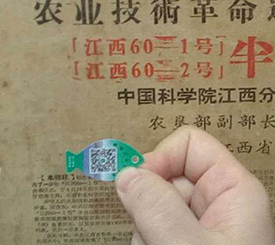
QR code from restaurant fish (Photo: Jocelyn Ford)
[RESTAURANT SOUNDS AND MUSIC]
FORD: Back in Beijing, at this Chairman Mao themed restaurant. An itinerant singer belts out songs for $7 a pop. My dinner party goes to a white-tiled fish tank as big as a queen-sized bed, to choose our dinner…live.
[SOUND OF FISH FLOPPING]
FORD: Our dinner has a tiny green fish-shaped tag on its fin, with a QR code.
So you just scanned it. And what does it tell us?
WOMAN: It’s just like a phone number who sold this fish. If you call the number, of course the person is going to tell you the fish is authentic. They sold this fish!
FORD: It's a gimmick. Like anyone could fake this, anyway.
WOMAN: Yeah, exactly, it’s not like a third party supervision, something.
FORD: But if Manish Kumar’s Fishin’ Company’s idea catches on of giving consumers 24-7 access to witness just how that fish got to their table, you can bet Chinese consumers will want the same thing for fish they put on their plates. And once that happens, the economies of scale would take over, and might make environmentally-friendly farmed fish more affordable for all. For Living on Earth, I’m Jocelyn Ford, in Beijing.
Related links:
- China Blue Sustainability Institute
- Stanford-led study says China's aquaculture sector can tip the balance in world fish supplies
- Hainan Tilapia Sustainability Alliance
- US FDA Import Alert pertaining to Chinese seafood
- Journal article on traditional Chinese medicine and fish immunity
- Hainan University (In Chinese)
- The Fishin' Company
[MUSIC: Hubei Song and Dance Ensemble of the People’s Republic of China, “Heroic Air of Chu,” on The Imperial Bells of China, Yin Dade / Peng Xiancheng, Fortuna Records]
CURWOOD: Coming up, climate, cash, and connectivity. The insights of one writer on the rapid pace of change for our planet. That’s just ahead here on Living on Earth. Stay tuned.
ANNOUNCER: Funding for Living on Earth comes from you our listeners, and United Technologies -- combining passion for science with engineering to create solutions designed for sustainability in the aerospace, food refrigeration and building industries. UTC companies such as Otis, Carrier, Pratt & Whitney, and UTC Aerospace Systems are helping to move the world forward.
This is PRI, Public Radio International.
[CUTAWAY MUSIC: Maria Kalaniemi & Aldargaz, “Slingerdansin,” on Iho, Olarin Musikki]
Beyond the Headlines

Oklahoma Attorney General Scott Pruitt is President-elect Donald Trump’s pick for EPA Administrator (Photo: Gage Skidmore, Flickr CC BY-SA 2.0)
CURWOOD: It’s Living on Earth, I’m Steve Curwood. Time to catch up with Peter Dykstra of DailyClimate.org and Environmental Health News, that's EHN.org. Peter joins us from Conyers, Georgia. Hi, Peter, I guess you have lots to tell us, including what’s going on with Donald Trump and his cabinet choices.
DYKSTRA: Hi, Steve. Yeah, you bet I do. Let’s first put this into perspective. Back up to just over a month ago. Most environmental advocates not only expected a Hillary Clinton presidency, but held out hope that her party could reach a majority in the Senate and make that body a lot greener.
CURWOOD: And of course we know neither of those things happened, huh.
DYKSTRA: So let’s look at the start of the past week. A shocker, with former Vice President Al Gore visiting Trump Tower on Monday and ending up talking climate change with the President-elect who at one point called it all a hoax, but more recently told the New York Times he has an open mind about climate.
CURWOOD: Raising new hopes among many of the same environmental activists.
DYKSTRA: Al Gore got a meeting, and good for him for trying. But 24 hours later, ExxonMobil CEO Rex Tillerson visited Trump for an audition for Secretary of State.
CURWOOD: Huh, that’s interesting. He’s the man who runs a company that’s under fire for allegedly misleading investors and the public about Exxon’s own research on climate change.
DYKSTRA: But wait, there’s more. On Wednesday, Scott Pruitt, Attorney General of Oklahoma, who’s leading some major lawsuits against the Environmental Protection Agency, including the Obama Clean Power Plan, is nominated to run EPA.
CURWOOD: So if confirmed, he’d be expected to turn the EPA around 180 degrees.
DYKSTRA: Or I think his critics might say, asking Scott Pruitt to lead the EPA is kind of like hiring a tornado to run your storm shelter.
CURWOOD: Well, give us some examples, then.
DYKSTRA: Much has been reported, not just in the past few days, but over Pruitt’s six years as AG in Oklahoma about his loyalty to the oil and gas industry, and the industry’s financial support for Pruitt. Not only is he regarded as a main architect behind the assault by state attorneys general on EPA’s Clean Power Plan, he’s also sued the agency he’s now expected to lead over air pollution and fracking rules, among other things. He has also issued flame-throwing statements about EPA usurping states’ rights in protecting the environment while he preaches climate denial. I found another obscure item from Pruitt’s career.
CURWOOD: Like what?
DYKSTRA: His predecessor as Oklahoma AG, Drew Edmondson, had sued the state’s poultry industry for water pollution in 2005. There was no resolution in the case by 2010, when Pruitt was elected with financial support from Big Chicken. And 11 years after the case was filed, the federal judge hasn’t budged, and Mr. Pruitt, now the Plaintiff, hasn’t pressed the case. The bottom line is that there’s outrage among environmental activists and Senators like Bernie Sanders and Tim Kaine, who promise a stormy and question-filled confirmation hearing, even though they almost certainly can’t muster enough votes to block his confirmation.
CURWOOD: Now, Peter, you usually flip back through the history calendar. What you got for us today?

A view of Ma’an, Jordan, near where scientists discovered riverbed pollutants from humans nearly 7,000 years ago. (Photo: Cliff Hellis, Flickr CC BY-NC-ND 2.0)
DYKSTRA: Well, over the past couple of centuries we’ve gotten pretty good at putting bad stuff in rivers. Great rivers like the Thames were open sewers dating back to medieval times. More recently, oil, industrial waste, toxic algae, and more in recent years, making India’s most sacred river, the Ganges, a serious health risk. And of course, you’ve got Cleveland’s Cuyahoga River, which frequently caught fire and burned in the '50s and '60s. But new research says we may have been ruining rivers since at least the end of the Stone Age, 7,000 years ago.
CURWOOD: I knew we were good at messing up rivers, but I had no idea we were that experienced at it.
DYKSTRA: Apparently we are. Researchers at the University of Waterloo in Canada tested a riverbed in southern Jordan, where the locals made copper by a primitive method of smelting, heating and burning copper ore. The waste they left behind contained heavy metals including copper residues, lead, zinc, cadmium, arsenic and mercury. This likely created some whopping health problems for the earliest people of the Bronze Age, but the contamination that can still be measured in this now-dry riverbed suggest it pretty much killed off a river as well.
CURWOOD: Wow, 7,000 years ago. Peter Dykstra is with Environmental Health News, that’s EHN.org and DailyClimate.org. Thanks Peter, we’ll talk to you soon.
DYKSTRA: Thanks, Steve. Talk to you soon.
CURWOOD: And there’s more on these stories at our website, LOE.org.
Related links:
- 93 stories from the EHN archive on Scott Pruitt
- New York Times: “Trump Picks Scott Pruitt, Climate Change Denialist, to Lead E.P.A.”
- Tulsa World: “Ex-attorney general puzzled at poultry suit ruling delay”
- Evidence suggests earliest humans polluted, too
[MUSIC: Django Reinhardt All Stars, “Manoir de mes reves,” on Django Reinhardt All Stars, Kind Of Blue Records]
Tom Friedman on the Age of Acceleration

Tom Friedman describes the current era as an “Age of Accelerations,” specifically of technology, globalization and the climate. (Photo: dconvertini, Flickr CC BY-SA 2.0)
CURWOOD: Global market forces, big leaps forward in technology, and unprecedented climatic shifts are defining the early 21st century, says author and New York Times columnist Tom Friedman. And in this world that is at once more interconnected and more divided than it's ever been, he asks us to stop, and reflect. From the eye in the storm, Tom Friedman says, we may learn how to ride out the hurricane of unprecedented change, sweeping up all of us. His newest book is called, "Thank You For Being Late: An Optimist’s Guide in The Age of Accelerations.” Welcome to Living on Earth, Tom.
FRIEDMAN: Great to be with you, Steve. Thank you for having me.
CURWOOD: So, what inspired you to write this book, "Thank You for Being Late"?
FRIEDMAN: I was inspired to write this book by a technical insight and an emotional reaction. The technical insight was, I read a book, it came out a couple years ago called, "The Second Machine Age" by Erik Brynjolfsson and Andrew McAfee from MIT, and it was about the acceleration and technology, the exponential acceleration and technology based on Moore's Law that the speed and power of microchips will double roughly every 24 months, which has been going on now for over 50 years. One of the hardest things for the human mind to grasp is the power of an exponential. In fact, they use the famous story from Silicon Valley, of the man who invented the game of chess and give it to the king, and the king said, “How can I reward you, good sir?”
And the man said, “I just want to feed my family.”
And the king said, “It shall be done. What would you like?”
And he said, “Your highness, I'd just like you to take one grain of rice and put it on the first square of this chessboard, then two on the second, four on the next, eight on the next, then 16 on the next, 32...and just keep doubling it, and my family will be fine.”
And then the king said, “Of course. It shall be done,” not realizing when you double something 63 times, the number you get is like 18 quintillion, more rice than existed in the world.
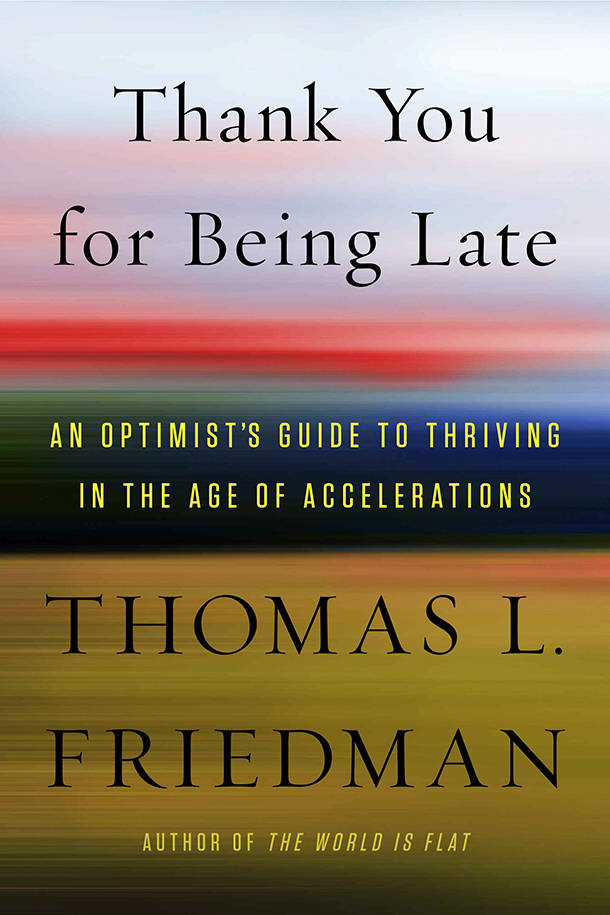
Friedman’s Thank You for Being Late is his seventh published book. (Photo: Courtesy of Caroline Zavakos)
So, what Andy and Eric argue is that in terms of Moore's law, we just entered the second half of the chessboard where the doubling starts to get very big, and the result is you get some very funky stuff. You now get cars that can drive themselves. You get computers that can beat any human in Jeopardy, chess, go, or now any other game. You get IBM Watson that's now ingested every article ever written basically on cancer.
So, the more I thought about their theory, the more I liked it. But the more I thought about it, the more I realized there are actually two other exponentials going on at the same time, and they are related. The second is the exponential in globalization, driven by Moore's law, not your grandfather's globalization. Not containers on ships. That's actually going down. But your millennials' globalization, that is the globalization of flows of ideas, whether on Twitter or Facebook or PayPal, etcetera. That's also accelerating. And, of course, the more I thought about that, the more I reflected on the fact because I had written a big book on environment and climate change, "Hot, Flat and Crowded" -- which I think is the last time we talked, Steve -- that Mother Nature was also in an exponential. The way in which CO2 is piling up in the atmosphere. The way in which it's impacts on the environment. The way in which biodiversity is being lost and population growth. So, when I really thought about it altogether, it struck me that wow, the Market, Mother Nature and Moore's law are only in simultaneous, nonlinear acceleration, and that's actually what's not just shaping the world today, but reshaping the world.
CURWOOD: So, you're observing all this and then, so what's your emotional response? What drives your then to put pen to paper -- I guess that's an anachronism isn't it? -- To put finger to keyboard to try to wrap all this together?
FRIEDMAN: Well, there's another thing going on with me, Steve. Really, I've spent so much of my journalism career, when I haven't been writing about environmental or foreign affairs generally, covering the Middle East. One of the things I've observed covering the Middle East that was increasingly depressing was the rise of tribal politics there and inability to route it out. What is the essence of tribal politics? Basically goes like this: I'm strong, why should I compromise? I'm weak how can I compromise? So, that's what you see between Israelis and Palestinians, Shiites and Sunnis today. Well, when you cover that, as I did for 30 years, you know, after a while it gets really depressing and you want to get away from it. So, I actually came home to America and really wanted to think about our country, and then I started to have a really dark feeling, Steve. It struck me that our own politics, Democrats and Republicans, were starting to behave like Shiites and Sunnis. You actually heard people saying, "I don't want my kid to marry one of them,” and one of them was someone from a different political party. Well, that was so depressing to me, to think that I had left America to discover the Middle East and now I had come back to America and the Middle East was chasing me here, that I began to think about where I grew up in Minnesota, a small suburb outside Minneapolis called St. Louis Park where this tribal behavior didn't exist, and when I grew up there, and it made me want to actually run away from both the Middle East and Washington, DC back to my roots. First of all to discern whether I just made it up, whether it was this really inclusive environment, community that I remembered it as, and, if it was, what were the lessons from it that I could share both with America and the world.
CURWOOD: Now, you may or may not agree, but my reading of your book shows this huge emphasis on polycultures, diversity. Describe the polycultures that you think are really important and what societies can do to nurture them?
FRIEDMAN: Well, Steve, let me answer by telling what I learned from Wes Jackson, the founder of the Land Institute out in Kansas where I’d gone to really learn about the wheat crisis a few years ago which was driven by global drought, wildfires and floods. And Wes explained to me that the prairie was a natural polyculture that naturally fertilized and pesticided itself, and when the settlers came basically they plowed up a lot of the prairie in places like Kansas, and they replaced this natural polyculture with monocultures. monoculture crops are wheat, corn and sorghum, and these monocultures to survive had to be artificially injected with high density fossil fuels in the form of fertilizer, pesticides, and tractors, basically.
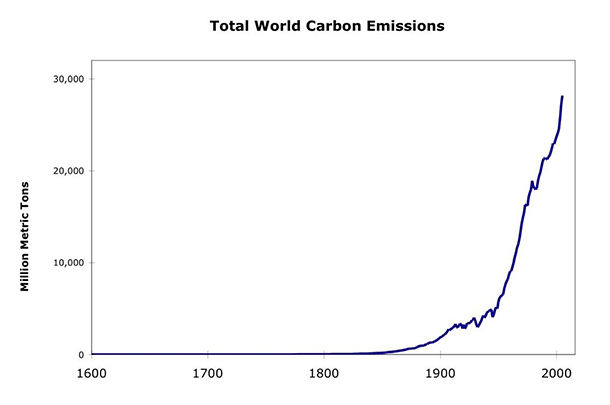
Friedman points to climate change as one of three major forces experiencing exponential change at the beginning of the 21st century. (Photo: Matt Lemmon, Flickr CC BY-SA 2.0)
And what Wes explained was, when the dust bowl happened, all the monocultures died, but the few bits of polyculture, natural prairie that were left, they all survived because they were more resilient. Well, as he explained that to me, Steve, I said to him, “Wes, when you when you think about the Arab world, the Arab world at its height was the world's greatest polyculture in Moorish Spain. It was a polyculture of ideas of people, of Christians, Muslims and Jews. The Arab world was never more prosperous than them, and what's happening today in the Arab world is that Al Qaeda and these Islamist groups are trying to wipe out that polyculture and replace it with a monoculture which is enormously susceptible to diseased ideas.”
Then, I really got a roll and I said, "Actually, think about the Tea Party. What the Tea Party tried to do was to take the polyculture of the Republican Party -- The Republican Party has been historically been a great polyculture. Teddy Roosevelt gave us National Parks. Ronald Reagan gave us radical arms control. Richard Nixon gave us the Clean Air and Clean Water Act. George HW Bush gave us cap and trade -- So, this is a party that had a polyculture of ideas, and the Tea Party was trying to wipe that out and replace it with a monoculture funded by high-density fossil fuel companies.
So wherever you see polycultures in nature you see Mother Nature's most resilient environments. Think of a rain forest, think of the places were two ecological zones meet. They can be very diverse and very resilient, and societies in my life that have been real polycultures, they're not only I think the richest, but they're actually the most fun to live in. So, I love Istanbul. I love Beirut. I love Hong Kong. I love Alexandria when Alexandria was Alexandria ... It was actually mostly before I was born ... And then think of the ones that are not polycultures. Riyadh, Saudi Arabia. How many great ideas have come out of Riyadh, Saudi Arabia? So, I'm a big believer in the power of polycultures, and I think it is part of the greatness of our country.
CURWOOD: What lessons then from how our natural systems achieve stability through endless acts of dynamism, specifically taking Mother Nature as an exemplary system of that?
FRIEDMAN: So, basically, the story I tell in my book is that we're in the middle of three nonlinear accelerations all at the same time, with the three largest forces on the planet. As I thought about that, Steve, I realize what we're not just in the middle of one climate change. We're in the middle of three climate changes at once. We're in the middle of a change in the climate of the climate, we're in the middle of the change of the climate of globalization, and we're in the middle of a change in the climate in technology. And then, it struck me that what do you want when the climate changes? Well, what you want are two things. You want resilience. You need to be able to take a blow cause you don't know when the disruption is going to come, but there will be disruptions, and the same time you want propulsion. You want to be able to move ahead. You don't want to be just curled up in a ball.
So, the more I thought about that, I said to myself, "Well, who can I talk to about how you build resilience and propulsion when the climate changes," and then it struck me that I knew this woman she's 3.8 billion years old and her name is Mother Nature and she has dealt with more climate changes than anybody. So I called her up, and I sat her down and I said, "Mother Nature, what are your killer apps for building resilience and propulsion when the climate changes?”
And she said, "Tom, well, everything I do I do unconsciously. First of all, I'm incredibly adaptive through natural selection in a very brutal way.
“Second," she said, "I love pluralism. I love diversity. My most diverse ecosystems are my most resilient and I love trying 20 different species and see who survives.
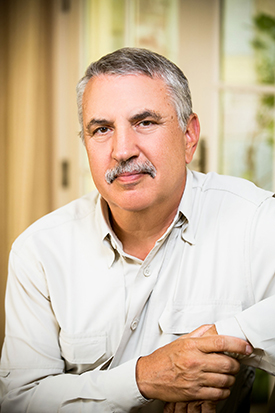
Tom Friedman is a New York Times columnist and bestselling author. (Photo: Ralph Alswang)
“Third," she said, "I'm incredibly sustainable in a very circular way. Everything is food. Eat, food, poop, seed, eat, food, poop, seed. Nothing is wasted in my world.
“Fourth," she said, "I'm incredibly entrepreneurial. Wherever I see you opening in nature, a blank space, I fill it with a plant or animal or both perfectly adapted to that niche.
“Fifth," she said, "I'm very patient I understand you can't speed up the gestation of an elephant or the growth of a thousand year old Baobab tree. That strength comes from patience.
“Sixth," she said, and this is very important, she said, "I'm very hybrid in my thinking. I'm very heterodox. I believe things should co-evolve, the right plants with the right soils, the right bees with the right flowers."
And lastly, she said, Steve, "I do believe in the laws of bankruptcy. I kill all my failures, return them to the great manufacturer in the sky, and take their energy to nourish my successes."
So the argument I make in the book is that the countries, communities and companies that most closely consciously mirror Mother Nature's killer apps are the ones that are going to thrive in what I called The Age of Accelerations". I'm a big believer in biomimicry.
Related links:
- Our interview with Tom Friedman for his earlier work, Hot, Flat and Crowded
- Read Tom’s latest columns for the New York Times here
- Tom Friedman’s newest book, Thank You For Being Late
[MUSIC: Al Hirt, “Nature Boy” from Music to Watch Girls By, Eden Ahbez, RCA Records]
CURWOOD: Tom Friedman's book is called, "Thank You for Being Late: An Optimist's Guide to Thriving in the Age of Accelerations," We'll continue our conversation with him next week, including his encounter with Donald Trump. The President-elect said he had an open mind on climate.
FRIEDMAN: There is a fine line between an open mind and no mind. And what I have been trying to do is explore through my journalism how open his mind is on this, truly.
CURWOOD: Part two of our chat with author and columnist Tom Friedman next time on Living on Earth.
CURWOOD: Living on Earth is produced by the World Media Foundation. Our crew includes Naomi Arenberg, Bobby Bascomb, Aidan Connelly, Savannah Christiansen, Jenni Doering, Jaime Kaiser, Don Lyman, Alex Metzger, Helen Palmer, Adelaide Chen, and Jolanda Omari. Tom Tiger engineered our show, with help from John Jessoe, Jake Rego and Noel Flatt. Alison Lirish Dean composed our themes. You can hear us anytime at LOE.org, and like us, please, on our Facebook page - PRI’s Living on Earth. And we tweet from @LivingOnEarth. I'm Steve Curwood. Thanks for listening.
ANNOUNCER1: Funding for Living on Earth comes you, our listeners, and from the University of Massachusetts, Boston, in association with its School for the Environment, developing the next generation of environmental leaders. And from the Grantham Foundation for the protection of the environment, supporting strategic communications and collaboration in solving the world’s most pressing environmental problems. Support also comes from the Energy Foundation, serving the public interest by helping to build a strong, clean, energy economy, from Gilman Ordway, and from SolarCity, America’s solar power provider. SolarCity is dedicated to revolutionizing the way energy is delivered by giving customers a renewable alternative to fossil fuels. Information at 888-997-1703. That’s 888-997-1703.
ANNOUNCER2: PRI. Public Radio International.
Living on Earth wants to hear from you!
Living on Earth
62 Calef Highway, Suite 212
Lee, NH 03861
Telephone: 617-287-4121
E-mail: comments@loe.org
Newsletter [Click here]
Donate to Living on Earth!
Living on Earth is an independent media program and relies entirely on contributions from listeners and institutions supporting public service. Please donate now to preserve an independent environmental voice.
NewsletterLiving on Earth offers a weekly delivery of the show's rundown to your mailbox. Sign up for our newsletter today!
 Sailors For The Sea: Be the change you want to sea.
Sailors For The Sea: Be the change you want to sea.
 The Grantham Foundation for the Protection of the Environment: Committed to protecting and improving the health of the global environment.
The Grantham Foundation for the Protection of the Environment: Committed to protecting and improving the health of the global environment.
 Contribute to Living on Earth and receive, as our gift to you, an archival print of one of Mark Seth Lender's extraordinary wildlife photographs. Follow the link to see Mark's current collection of photographs.
Contribute to Living on Earth and receive, as our gift to you, an archival print of one of Mark Seth Lender's extraordinary wildlife photographs. Follow the link to see Mark's current collection of photographs.
 Buy a signed copy of Mark Seth Lender's book Smeagull the Seagull & support Living on Earth
Buy a signed copy of Mark Seth Lender's book Smeagull the Seagull & support Living on Earth

